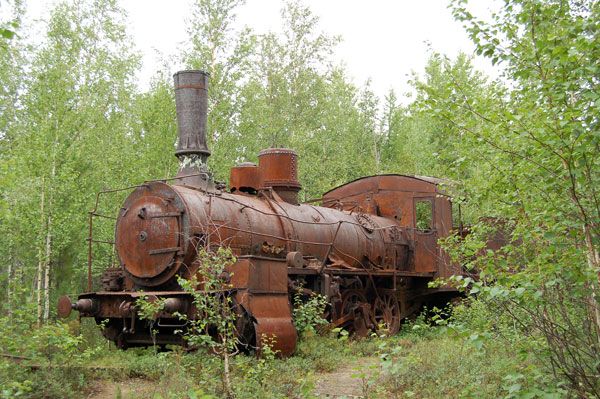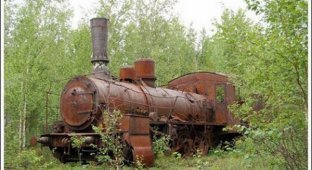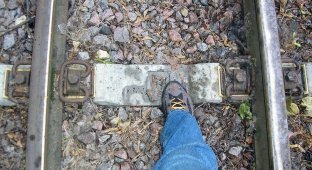Dead road. Abandoned locomotives (47 photos and many letters)
Dead road... This eerie epithet appeared in everyday life relatively recently, when articles, books, and stories began to be written about this story. It just so happened that, unlike the Trans-Siberian Railway, BAM and even the Pechora Railway, the construction of the Salekhard-Igarka highway did not have its own established name. Polar, polar, transpolar road - as they called it. It went down in history by the numbers of construction departments - No. 501 and 503 GULZhDS NKVD of the USSR, and most often they remember the “five hundred and first”, spreading this number throughout its entire length. But what suits it best is the name “Dead Road,” which reflects the fate of both the highway itself and many of its builders.
After the Great Patriotic War, the country's leadership and I.V. Stalin clearly realized the vulnerability of the strategic route - the Northern Sea Route. Its main ports, Murmansk and Arkhangelsk, were located too close to the western borders of the USSR, and in the event of a new war, communication along the NSR could easily be paralyzed by the enemy. It was decided to create a new port in the Gulf of Ob, in the area of Cape Kamenny, and connect it by a 700-kilometer railway with the already existing Kotlas-Vorkuta line. The main provisions for future construction were determined by Resolution of the Council of Ministers of the USSR No. 298-104ss of 02/04/1947, and by Resolution No. 1255-331ss of 04/22/1947 construction was entrusted to the GULZhDS (main department of camp railway construction) of the NKVD-MVD of the USSR.
Construction of the line began simultaneously with the search for a site for the future port. After some time, it became clear that the Gulf of Ob is completely unsuitable for such construction - very shallow depths, large wind surges and water surges do not allow the construction of any large port on its shores. Already in January 1949, a fateful meeting between I.V. Stalin, L.P. Beria and N.A. Frenkel, the head of the GULZhDS, took place. It was decided to curtail work on the Yamal Peninsula, stop construction of the line to Cape Kamenny, and begin laying a 1,290 km long railway. to the lower reaches of the Yenisei, along the highway Chum - Labytnangi - Salekhard - Nadym - Yagelnaya - Pur - Taz - Yanov Stan - Ermakovo - Igarka, with the construction of a port in Igarka. This was enshrined in decree No. 384-135ss of January 29, 1949. In the future, it was planned to extend the line from Dudinka to Norilsk.
Construction Department No. 502, which was involved in laying a line from Chum station of the Pechora railway to Cape Kamenny with a branch to Labytnangi, was abolished, and two new departments were created - western No. 501 with a base in Salekhard, which was in charge of the section from Labytnangi to the river. Pur, and eastern department No. 503 with a base in Igarka (later moved to Ermakovo), which built the road from Pur to Igarka. The concentration of manpower and materials between these constructions was distributed approximately 2:1.
The technical conditions for laying the line were extremely light; bridges across the Ob, Pur, Taz and Yenisei were not planned at the first stage - they
The function was to be performed by ferries in summer, and ice crossings in winter. Excavation work was carried out mainly by hand, long-distance transportation of soil was carried out using a few vehicles, and filling of the embankment was carried out using hand wheelbarrows. 100-140 km of the route were completed per year on the western section, much less on the eastern section: due to the lack of people and the difficulty of transporting materials.
At this construction site, the terrible phrase that was born during the construction of the Pechora Railway - about “a man under every sleeper” - acquired its literal meaning. Thus, I. Simonova from Tashkent, who worked as an engineer in the 1970s on the survey and completion of the Nadym-Urengoy section, personally saw piles of skeletons after the banks of the Hetta River were washed away, and corpses in the embankment 616-620 kilometers of the line.
In October 1949, ice bound the Ob, and in early November sleepers and rails were already laid on it. A daredevil was needed who would be the first to experience the “ice”. This was not the case among civilian drivers. “Whoever overtakes the locomotive is free,” ordered the construction manager. A volunteer prisoner was found who took it upon himself to drive the locomotive. At first everything went well, but towards the middle of the river the ice began to crack and break. The driver looked out of the booth and was stunned - the Ob abyss, swallowing sleepers and rails, was menacingly approaching the locomotive. But the ice and rail lashes survived. The driver reached the shore and received the longed-for freedom. On the eve of November 7, the authorities reported to Stalin about a new labor victory in the 501st.
Traffic from Salekhard to Nadym was opened in August 1952, and a work-passenger train began running. By 1953, the embankment had been filled almost to Pura, and part of the rails had been laid. In the eastern sector, things were not going so well. A 65-kilometer section from Igarka to Ermakov, as well as about 100 km, was filled and laid. In a westerly direction to Janow Stan and beyond. Materials were brought to the Taz River area, and about 20 km were built here. main passage and depot with repair shops. The least developed was the 150-kilometer section between the Pur and Taz rivers, which was planned to be built by 1954.
A telegraph and telephone line was built along the entire route, which until the 70s connected Taimyr with the outside world. The operation of its section from Yagelnaya to Salekhard was stopped only in 1992.
After the death of I.V. Stalin, when more than 700 of the 1290 km had already been laid. roads, almost 1,100 were filled, about a year remained before commissioning, construction was stopped. Already on March 25, 1953, Decree No. 395-383ss was issued on the complete cessation of all work. Soon, 293 camps and construction departments were disbanded. An amnesty was declared for hundreds of thousands of prisoners, but they were able to go south only with the beginning of navigation - there were no other routes yet. According to some estimates, about 50 thousand prisoners were taken from construction sites 501 and 503, and about the same number of civilian personnel and members of their families. They took everything they could to the “Mainland,” but most of what was built was simply abandoned in the taiga and tundra.

Steam locomotive Ov-3821 near the ruins of the Dolgoe depot.

Platforms on a dead-end track near the depot.

The path towards Igarka.

Rails and rolling stock were brought from different places for construction. There are also Demidov rails from the 19th century.

Steam locomotive Ov-6154.

Loneliness.

These locomotives will never stop at any depot again...

Steam locomotive Ov-6698.

Arrow in the depot.

Wheelset with spokes. Now there are almost no such people.

There was no war here. The government just lost interest...

This platform was apparently used by railway workers.

The remains of freight cars are densely overgrown with young forest. Another 50-70 years will pass, and the taiga will absorb everything else.

Platform in the swamp.

A two-kilometer dead-end line to the north along the bank of the Taz River. Why it was built is unclear, there are no quarries there, the line simply ends in the open forest.

Such overlays were also on the main course. On the other side of them were attached wooden plates, now almost rotten.

Again a pre-revolutionary rail. Demidov plant, Nizhny Tagil.

The line is overgrown.

Diesel on the bank of the Taz River. Possibly from more recent times. Not a single flood can move him from his place...

View from the driver's booth.

Depot Long. A few more years and he too will be gone.

Rust and cobwebs.

Despite the beginning of the introduction of automatic coupling, the rolling stock of GULZhDS still had a screw harness.

There were workshops here.

Radiator from the tractor "Stalinets".

Near the depot, the rails were removed from the branch leading to the main passage. Apparently they were taken out along the river.

Turnout details.

Arrow details again.

Beyond this point the rails have been preserved.

Trees grow along the rails - there is a different local microclimate there. A similar picture can be observed in old mountain trails.

The 1879 rail is the oldest found. Where did it lie before?...

Strange vandalism.

Contrary to some opinions, metal ties were also used on the Polar Highway. They helped maintain the gauge when the sleepers and fastenings were weak.

Young boletus.

Exit to the embankment.

Gulch.

Trains haven't run here for a long time.

Many small bridges and pipes ceased to exist. You have to cross such gullies. The boards below are not only sleepers - the embankment was poured on a wooden base, in the image of medieval ramparts.

All-terrain vehicles of gas workers do not spare the Dead Road. She is nothing to them, a hindrance.

Another confirmation of the presence of wooden cages at the base of the embankment.

And this is the youngest rail found - 1937. For some reason we expected to see only these there.

There are also normal fastenings. But there were still not enough materials for the upper structure of the track.

The subsidence of depot tracks gives such misalignment.

Boxcar. The quality of the boards is enviable.

And here is the solution - the carriage is German. Apparently the trophy was converted to our track and transferred to GULZDS.

Barbed wire. We didn’t reach the camp, but there is plenty of it in the vicinity of the depot.

Steam locomotive Ov-4171 and expedition members. In the middle is your humble servant)
Economists subsequently calculated that the decision to abandon construction at such a stage of readiness led to losses for the country’s budget much greater than if the road had been completed, not to mention its promising continuation to the Norilsk industrial region, where the richest deposits of iron and copper were already being developed , nickel, coal. The giant gas fields of Western Siberia have not yet been discovered - who knows, maybe then the fate of the road would have been completely different.
The fate of individual sections of the road varies greatly. The head section of Chum-Labytnangi was accepted into permanent operation by the Ministry of Railways in 1955. The fully completed Salekhard-Nadym line was abandoned and was not restored. Until the early 90s, signalmen servicing that same telegraph and telephone line rode along it on a semi-homemade handcar. The section from Pura (now Korotchaevo station) to Nadym was restored by the Ministry of Oil and Gas Industry in the 70s, and in the early 80s a new highway came to Korotchaevo from the south - from Tyumen. The condition of the route from Korotchaevo to Nadym was unimportant; in the mid-90s, passenger trains from the south were shortened to Korotchaevo station, and only in 2003 the Korotchaevo-Novy Urengoy (formerly Yagelnaya) section was put into permanent operation. The rails were removed from the eastern section of the road in 1964 for the needs of the Norilsk plant.
Only the “island” section in the area of the Taz River remained practically untouched - about 20 km from the Sedelnikovo pier on the right bank. towards Ermakovo, with a branch to the Dolgoe depot and the ballast quarry. It was on this site, the most inaccessible of all the others, that the track, buildings, depot and four Ov steam locomotives - the famous “sheep” of pre-revolutionary construction - remained almost untouched. On the tracks near the depot there are several dozen cars - mostly flat cars, but there are also a few covered ones. One of the cars came here from post-war Germany, after being converted to the domestic 1520 mm gauge. 15 km. from Dolgoye, the remains of a camp have been preserved, and not far from the depot, on the other bank of the stream, there are the remains of a settlement of civilian workers and the construction administration, consisting of almost two dozen buildings, as well as a wooden ferry lying on the shore. We visited this area.
The future fate of the Dead Road no longer looks so bleak. The continued development of hydrocarbon reserves in adjacent areas forces Gazprom and the administration of the Yamal-Nenets Autonomous Okrug to look for new ways to supply and transport materials. The issue of restoring the Nadym-Salekhard section and building a line from Korotchaevo to the Yuzhno-Russkoye field, passing also along the 503rd construction route, are already being considered. Only Norilsk, with the current volumes of ore production, looks at all this calmly, content with year-round icebreaker navigation along the NSR. But the reserves of its deposits are very large, and the world needs nickel and base metals. Who knows…























